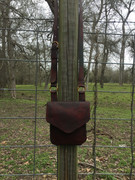I filled an old plastic coffee can with an inch of clear ammonia, and a paper towel. Then I sprinkled two pinches of kosher salt into the can. Then I suspended the parts, with a wire, above the ammonia. I sprayed the parts with ammonia, sprinkled the same salt on them, another light spray of ammonia after that; then sealed the can, and let it sit out in the sun all day. When I got home later that night, I dunked all the parts in baking soda, and water to stop the reaction. Then rinsed the parts off...



















